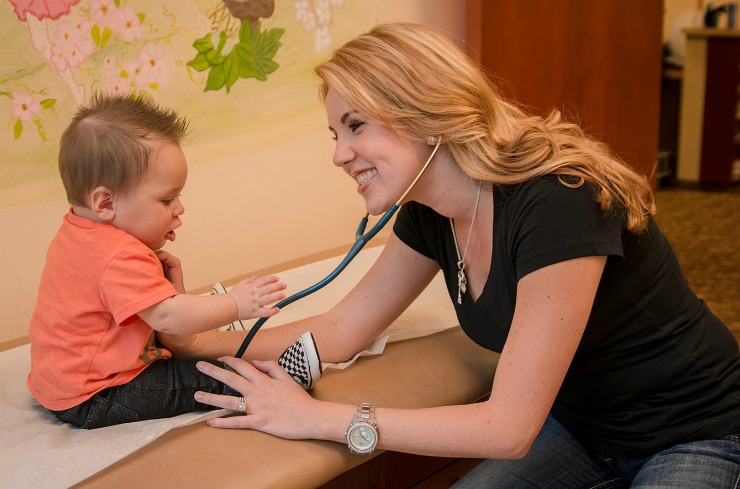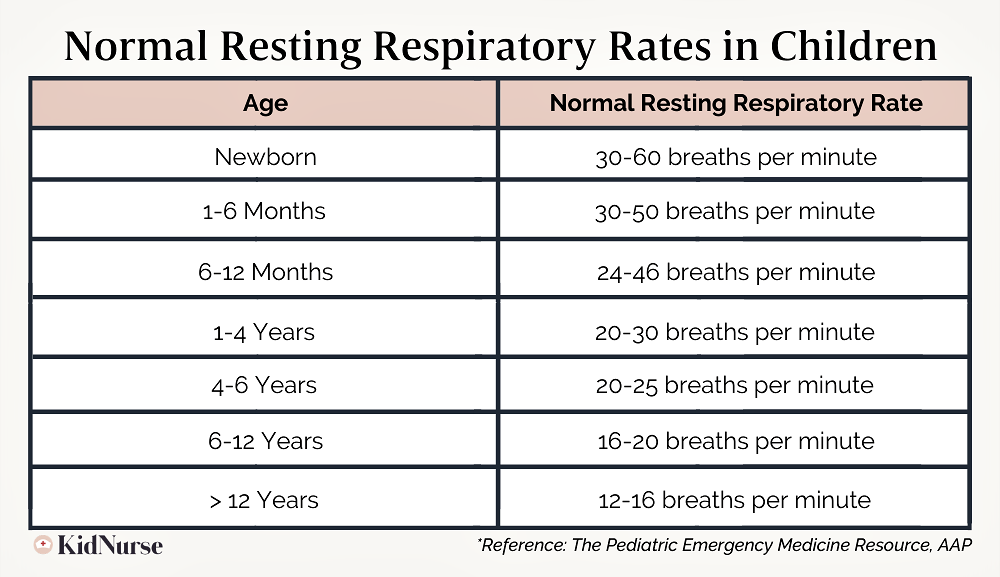Signs Of Respiratory Distress In Children All Parents Need To Know
February 12, 2018
One of parents’ greatest concerns when their child is sick is whether or not their child is having difficulty breathing, or respiratory distress. Pediatric respiratory disorders are the second most common cause of pediatric ER visits across the United States. Tragically, breathing difficulties can and do lead to respiratory failure and death if not treated promptly.
While working in both primary and urgent care settings, I would unfortunately regularly treat children in respiratory distress. Moms would have a look of horror as I had to inform them of their child’s respiratory decline. Symptoms of pediatric respiratory distress can be somewhat easy to miss as a parent, especially if you have never seen a child struggling to breath before. Sometimes these symptoms can develop subtly and quickly.
Of all the subjects I’ve taught parents about over the years, when it comes to pediatric illness, understanding respiratory distress is the most important issue to recognize quickly and take appropriate action. Your child’s life can depend on it. While you may have talked with your pediatric provider before about this topic, this blog post is actually intended to show you pediatric respiratory distress using real videos and explanations, so you can better recognize the symptoms and give your child the best care.

Symptoms of Respiratory Distress in Children
When trying to determine if a child is in respiratory distress, it’s important to understand how to calculate your child’s respiratory rate. This is the total amount of breaths your child takes in 1 minute. To count this, simply set a timer for 60 seconds and count every breath your child takes during that time.
Pediatric respiratory rates vary according to age (infants naturally breath slightly faster than older children), so reference your child’s age in the below chart to understand what their appropriate respiratory rate should be.

Tachypnea – Fast Breathing
Tachypnea, or fast breathing, is an important sign of respiratory distress, and it often presents at the beginning of a child’s respiratory decline.
Tachypnea is a respiratory rate that is:
- More than 60 breaths in infants 0–2 months of age
- More than 50 breaths in infants 2 to 12 months
- More than 40 breaths in children 1 to 5 years
- More than 20-30 breaths in children more than 5 years of age
As a child’s body starts working harder to breath, the body will automatically start breathing faster. For example, a child may have cold symptoms for several days, but when you start seeing an increase in their respiratory rate that becomes tachypneic, you should recognize that they are working harder to breath and they need medical attention.

This is a good example of a child who has tachypnea and retractions:
Video Link: Tachypnea and Retractions
Low Pulse Oximetry And Respiratory Distress
Chances are good you have seen a medical professional use a pulse oximeter to measure the oxygen saturation of your blood. We use this medical tool in children all the time to help assess their ability to breath and oxygenate their blood. In older children, we can attach the pulse oximeter to their finger and in infants we typically connect the probe to their large toe.
A healthy child’s pulse oximetry reading should be approximately 95% or greater. Most healthy children average from 97-100% at any given time. If a child’s pulse oximetry is below 95%, they should be evaluated by your pediatric provider.
Medical grade pulse oximeters available at hospitals and medical offices provide the most accurate readings, however, there are some home models that can be helpful for some parents. For children ages 2 and older, I like using this Acc U Rate pulse oximeter for children. Infants’ fingers are too small for a classic finger model. I think the best commercially available pulse oximeter for infants is the Owlet smart sock.
It’s important to note that pulse oximetry is just one way of evaluating a child’s respiratory function. It is only one piece of the overall picture. All of the other signs and symptoms described in this post are just as important. Monitoring pulse oximeter tends to be most helpful for children who are prone to respiratory illnesses or asthma, but many of the parents I work with find it helpful to have on hand when trying to decide if their child has a common cough or if they need further medical attention.
Wheezing
Wheezing is one of the most common symptoms associated with respiratory distress. It is a high-pitched musical noise that the lungs make when they are tight and pushing air through narrowed airways. A great analogy for wheezing is like trying to breathe through a coffee straw. Exhausting! Wheezing is commonly associated with asthma, but children of all ages with many different respiratory illnesses can wheeze.
It’s very important to seek medical attention if your child is wheezing, as this is a very common symptoms of respiratory distress. There are many medications that can help wheezing children breathe dramatically better, including albuterol. Don’t delay in getting care.
Here are two good examples of children who are wheezing:
Video Link: Wheezing With Retractions
Retractions
There are many muscles involved in breathing, including the diaphragm, intercostal muscles (the muscles in-between your child’s ribs), abdominal muscles, and muscles by the neck and collarbone. These muscles work together to help the lungs expand and contract, drawing air in and out of the lungs.
 When a child is breathing well, breathing is effortless. The chest will rise and fall without thought or difficulty as all these muscles work seamlessly together. However, when children are in respiratory distress, these chest muscles have to work in overdrive to move air in and out of the lungs.
When a child is breathing well, breathing is effortless. The chest will rise and fall without thought or difficulty as all these muscles work seamlessly together. However, when children are in respiratory distress, these chest muscles have to work in overdrive to move air in and out of the lungs.
When you can see the chest wall muscles straining to help a child breath, we call this retractions. Retractions can occur in many different muscles on the chest wall and are labeled according to where they anatomically occur. Many times, these retractions occur together.
Subcostal Retractions occur toward the bottom of the ribs.
Here are two examples of subcostal retractions:
Video Link: Subcostal Retractions in Infant
Video Link: Subcostal Retractions in Infant
Substernal Retractions occur at the bottom of the sternum.
Here is an example of substernal and subcostal retractions in a toddler:
Video Link: Substernal and Subcostal Retractions in Toddler
Intercostal retractions occur in-between your child’s ribs.
These retractions cause the rib cage to protrude. Here is an example of intercostal and suprasternal retractions in a young child:
Video Link: Intercostal and Suprasternal Retractions in Young Child
Suprasternal retractions occur at the top of the sternum.
In addition to the above video, here is an example of suprasternal retractions in a toddler:
Video Link: Suprasternal Retractions in Toddler
Supraclavicular retractions occur right above the clavicles (collarbones)
Respiratory infections are the most common cause of respiratory distress and retractions. These infections commonly include RSV, pneumonia, and bronchitis. Asthma or reactive airway disease is also a very common culprit as well. If you see ANY retractions happening while your child is breathing, your child is working too hard to breathe. Retractions are an immediate reason to seek emergency medical care.
Grunting
If your child is grunting, you will be able to hear it when your child exhales. Some babies make occasional grunting sounds during sleep, but regular grunting paired with rapid, shallow breathing is a sign of serious respiratory distress.
You can hear this child in respiratory distress grunting every time he exhales; he also has retractions:
Stridor
Stridor is a high-pitched, harsh respiratory sound caused by turbulent airflow through a narrowed upper airway. While it can be caused by various conditions, it is commonly heard in children that have croup.
Stridor in an older child:
Nasal Flaring
Nasal flaring occurs when the nostrils widen while a child is breathing and is a sign of respiratory distress. If you watch this baby’s nose you will see nasal flaring and you may notice that he also has both subcostal and substernal retractions:
Color Changes
Children in respiratory distress are usually pale, grayish or dusky in appearance. You may even notice a blue color around a child’s lips and mouth area or possibly pale or blue fingernails. Blue discoloring is a late sign that your child isn’t getting enough oxygen and is an emergency.
Changes in alertness
Children in respiratory distress can become fatigued and lethargic, sometimes very quickly. The body can only work in overdrive to breathe for so long before it becomes exhausted, especially with children. Exhaustion and decreased levels of consciousness and late symptoms of respiratory distress and require immediate medical attention.
Progression Of Respiratory Distress to Respiratory Failure In Children
Below is a graph to help you understand the progression of children in respiratory distress. A child’s body will continue to create more and more respiratory effort and labored breathing in an attempt to breathe better. As the body works harder to get oxygen, you will usually see an increase in the symptoms described above (increased respiratory rate, coughing, retractions, etc). However, if a child’s respiratory distress goes untreated, a child can reach a point of exhaustion and a decline in respiratory effort is seen. That is what we consider to be respiratory failure, and this is incredibly dangerous.

It is very important to seek medical care when you start seeing symptoms of increased respiratory effort. If you wait too long, your child can rapidly decline. In children, this can happen very suddenly.
If your child has had labored breathing, coughing, wheezing, or any of the other symptoms described in this post, and suddenly becomes extremely tired or lethargic, this is a medical emergency.
It’s important to remember that the many symptoms of pediatric respiratory distress that I talked about in this post regularly occur together, but they can also occur individually. For example, a child may have tachypnea and retractions, or they may present with wheezing alone. If your child is sick and showing ANY of the above symptoms of respiratory distress, seek medical care. It’s always the right decision to take your child to their pediatric provider for further evaluation if you aren’t sure. As tempting as it can sometimes be, don’t downplay their symptoms, hoping they will get better.
My hope with this post is that you will have a better understanding of the symptoms we look for when evaluating your child’s breathing for respiratory distress. Just remember, it is always better to be on the safe side when it comes to your child’s breathing!
Author: Dani Stringer, MSN, CPNP, PMHS – founder of KidNurse and MomNurse Academy